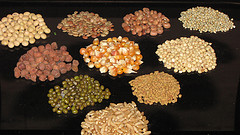
flic.kr/p/7drgKP
Liquid lecithin is a naturally occurring compound found in every cell of every living organism, whether of animal or plant in origin. In fact, while the liquid lecithin sold in the commercial industry is a mixture of neutral and polar lipids (glycolipids, sterols, triglyderides and small quantities of fatty acids, carbohydrates, and sphingolipids), lecithin in biochemistry is often used as a synonym for phosphatidylcholine (PC), which is itself a mixture of differently substituted sn-glycerol-3-phosphatidylcholine backbones.
Phosphatidylcholine is known as a major component of a phosphatide fraction. When isolated from either soya beans or egg yolk, this form of liquid lecithin is commercially available in high purity and used for a variety of purposes in the food industry as well as other industries. For the most part, however, liquid lecithin is utilized as an emulsifier, and is in fact one of the limited number of emulsifiers commonly regarded as safe to use.
Benefits
While lecithin is a natural part of the body, it is not an essential nutrient, not like fatty acids or amino acid. Our bodies already have lecithin and can manufacture more, if required. However, what is essential is the synthesized form of liquid lecithin, which is choline.
Our bodies receive choline from phosphatidylcholine component in liquid lecithin. To preserve cell membrane integrity and facilitate the movement of fats in and out of cells, as well as ions, wastes, and nutrients, we need a constant supply of choline. Additionally, the neurotransmitter acetylcholine needs choline for its normal functions. Because of liquid lecithin’s choline make up, the compound has been touted as a memory enhancer by improving cognitive function.
Additional benefit of liquid lecithin is to increase the rate at which fat is burned to produce energy for the body. Lecithin is controlled in the bile, which is a kind of substance produced by the liver and stored in the gallbladder necessary for digestion. As an emulsifier, the function of liquid lecithin is to separate the fatty acids in the bile and safeguard them from the ravages of oxidation. The compound also helps keep the liver cells healthy so they can continue doing their function of filtering and cleansing the blood of all toxins and damanging molecules.
Sources
Liquid lecithin can be found in nearly all types of food. But the richest sources of liquid lecithin are those that are high in fat and cholesterol, such as eggs, organ meat, red meat, etc. Soybeans are also known as good sources of liquid lecithin. In fact, majority of commercial lecithin sold in the market today are taken from soybean oil even as the first lecithin was separated from egg yolk in 1850.
Every individual needs adequate supply of liquid lecithin. While it is true that there are only very rare cases of lecithin deficiency, including lecithin-foods in your meal is one good way of protecting yourself from cholesterol-related problems. What’s more, when the body synthesis lecithin, it becomes choline, which is very crucial to your body’s health. Without it, symptoms of liver cancer or cirrhosis could develop and many bodily functions may suffer due to the absence of choline.
Tagged with: lecithin benefits • soya benefits
Filed under: Lecithin